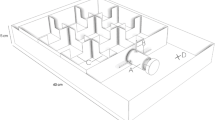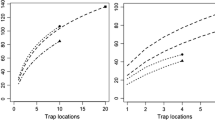Abstract
Bats are currently killed in large numbers at wind turbines worldwide, but the ultimate reason why this happens remains poorly understood. One hypothesis is that bats visit wind turbines to feed on insects exposed at the turbine towers. We used single molecule next generation DNA sequencing to identify stomach contents of 18 bats of four species (Pipistrellus pygmaeus, Nyctalus noctula, Eptesicus nilssonii and Vespertilio murinus) found dead under wind turbines in southern Sweden. Stomach contents were diverse but included typically diurnal flies, e.g. blow-flies (Calliphoridae), flesh-flies (Sarcophagidae) and houseflies (Muscidae) and also several flightless taxa. Such prey items were eaten by all bat species and at all wind turbine localities and it seems possible that they had been captured at or near the surface of the turbines at night. Using sticky traps, we documented an abundance of swarming (diurnal) ants (Myrmica spp.) and sometimes blow-flies and houseflies at the nacelle house. Near the base of the tower the catches were more diverse and corresponded better with the taxa found in the bat stomachs, including various diurnal flies. To evaluate if flies and other insects resting on the surface of a wind turbine are available to bats, we ensonified a house fly (Musca) on a smooth (plastic) surface with synthetic ultrasonic pulses of the frequencies used by the bat species that we had sampled. The experiment revealed potentially useful echoes, provided the attack angle was low and the frequency high (50–75 kHz). Hence resting flies and other arthropods can probably be detected by echolocating bats on the surface of a wind turbine. Our findings are consistent with published observations of the behavior of bats at wind turbines and may actually explain the function of some of these behaviors.
Similar content being viewed by others
References
Ahlén, I., Bach, L, Baagøe, H.J., Pettersson, J., 2007. Bats and Offshore Wind Turbines Studied in Southern Scandinavia. Swedish Environmental Protection Agency, Stockholm, report 5571.
Arnett, E.B., Brown, W.K., Erickson, W.P., Fiedler, J.K., Hamilton, B.L., Henry, T.H., Jain, A., Johnson, G.D., Kerns, J., Koford, R.R., Nicholson, C.P., Oı´Connell, T.J., Piorkowski, M.D., Tankersley, R.D., 2008. Patterns of bat fatalities at wind energy facilities in North America, J. Wildl. Manag. 72, 61–78.
Arnett, E.B., Huso, M.M.P., Schirmacher, M.R., Hayes, J.P., 2011. Altering turbine speed reduces bat mortality at wind-energy facilities, Front. Ecol. Environ. 9, 209–214.
Arnett, E.B., Baerwald, E.F., Mathews, F., Rodrigues, L, Rodriguez-Duran, A., Rydell, J., Villegas-Patraca, R., Voigt, C.C., 2015. Impacts of wind energy development on bats: a global perspective. In: Voigt, C.C., Kingston, T. (Eds.), Bats in the Anthropocene: Conservation of bats in a changing world. Springer-Verlag, Berlin, pp. 295–324.
Bartonicka, T., Rehák, Z., Andreas, M., 2008. Diet composition and foraging activity of Pipistrellus pygmaeus in a floodplain forest, Biologia 63, 266–272.
Baerwald, E.F., D’Amours, G.H., Klug, B.J., Barclay, R.M.R., 2008. Barotrauma is a significant cause of bat fatalities at wind turbines, Curr. Biol. 18, R695–R696.
Barlow, K.E., 1997. The diets of two phonic types of the bat Pipistrellus pipistrellus in Britain, J. Zool. Lond. 243, 597–609.
Britton, A.C.R., Jones, G., Rayner, J.M.V., Boonman, A.M., Verboom, B., 1997. Flight performance, echolocation and foraging behaviour in pond bats Myotis dasycneme (Chiroptea: Vespertilionidae), J. Zool. Lond. 241, 503–522.
Camacho, C, Coulouris, G., Avagyan, V., Papadopoulos, J., Bealer, K., Madden, T.L., 2009. BLAST+: architecture and applications. BMC Bioinformatics 10, 421, https://doi.org/10.1186/1471-2105-10-421
Chappell, M.A., Morgan, K.R., 1987. Temperature regulation, endothermy, resting metabolism, and flight energetics of tachinid flies (Nowickia spp.), Physiol. Zool. 60, 550–559.
Clare, E.L., Fraser, E.E., Braid, H.E., Fenton, M.B., Hebert, P.D.N., 2009. Species on the menu of a generalist predator, the eastern red bat (Lasiurus borealis): using a molecular approach to detect arthropod prey, Mol. Ecol. 18, 2532–2542.
Clare, E.L., Barber, B.R., Sweeney, B.W., Hebert, P.D.N., Fenton, M.B., 2011. Eating local: influences of habitat on the diet of little brown bats (Myotis lucifugus), Mol. Ecol. 20, 1772–1780.
Couer d’acier, A., Cruaud, A., Artige, E., Genson, G., Clamens, A.L., Pierre, E., Hudaverdian, S., Simon, J.-C.Jousselin, E., Rasplus,J.-Y., 2014. DNAbarcoding and the associated PhylAphidB@se website for the identification of European Aphids (Insecta: Hemiptera: Aphididae). PLoS One, e97620.
Cryan, P.M., 2008. Mating behavior as a possible cause of bat fatalities at wind turbines, J. Wildl. Manag. 72, 845–849.
Cryan, P.M., Barclay, R.M.R., 2009. Causes of bat fatalities at wind turbines: hypotheses and predictions, J. Mammal. 90, 1330–1341.
Cryan, P.M., Gorresen, M.P., Hein, CD., Schirmacher, M.R., Diehl, R.H., Huso, M.M., Hayman, D.T.S., Fricker, P.D., Bonaccorso, F.J., Johnson, et al., 2014. Behavior of bats at wind turbines, Proc. Natl. Acad. Sci. U. S. A. 111, 15126–15131.
Douwes, P., Abenius, J., Cederberg, B., Wahlstedt, U., Hall, K., Starkenberg, M., Reisborg, C, Östman T., 2012. Nationalnyckelntill Sveriges flora och fauna. Steklar: Myror-getingar. Hymenoptera: Formicidae-Vespidae. ArtDatabanken, SLU, Uppsala.
Dudek, K., Dudek, M., Tryjanowski, P., 2015. Wind turbines as overwintering sites attractive to an invasive lady beetle, Harmonia axyridis Pallas (Coleoptera: Coccinellidae), Coleopt. Bull. 69, 665–669.
Faure, PA, Fullard, J.H., Dawson, J.W., 1993. The gleaning attacks of the northern long-eared bat, Myotis septentrionalis, are relatively inaudible to moths, J. Exp. Biol. 178, 173–190.
Hale, A., McAlexander, A., Bennett, V., Cooper, B., 2013. A test of a novel attraction hypothesis. Why are bats attracted to wind turbines? Abstracts of 16th International Bat Research Conference and 43rd North American Symposium on Bat Research, San José, Costa Rica, p. 64.
Horn, J.W., Arnett, E.B., Kunz, T.H., 2008. Behavioral responses of bats to operating wind turbines, J. Wildl. Manag. 72, 123–132.
Huson, D.H., Mitra, S., Ruscheweyh, H.J., Weber, N., Schuster, S.C., 2011. Integrative analysis of environmental sequences using MEGAN4, Genome Res. 21, 1552–1560.
Jiang, Y., Yang, Z., Wang, X., Hou, Y., 2015. Molecular identification of sibling species of Sclerodermus (Hymenoptera: Bethylidae) that parasitize buprestid and cerambycid beetles by using partial sequences of mitochondrial DNA cytochrome oxidase subunit 1 and 28S ribosomal RNAgene. PLoS One 10 (3), e0119573.
Kunz, T.H., Arnett, E.B., Erickson, W.P., Hoar, A.R., Johnson, G.D., Larkin, R.P., Strickland, M.D., Thresher, R.W., Tuttle, M.D., 2007. Ecological impacts of wind energy development on bats; questions, research needs, and hypotheses, Front. Ecol. Environ. 5, 315–324.
Lehnert, L.S., Kramer-Schadt, S., Schönborn, S., Lindecke, O., Niermann, I., Voigt, C.C., 2014. Wind farm facilities in Germany kill noctule bats from near and far. PLoS One 9 (8), e103106.
Oba, Y., Ôhira, H., Murase, Y., Moriyama, A., Kumazawa, Y., 2015. DNA barcoding of Japanese click beetles (Coleoptera, Elateridae). PLoS One 10(1), e0116612.
Pape, T., 1987. The Sarcophagidae (Diptera) of Fennoscandia and Denmark, Fauna Entomologica Scandinavica. 19, Leiden : Brill/Scandinavian Science Press.
Peng, R.K., Sutton, S.L., Fletcher, C.R., 1992. Spatial and temporal distribution patterns of flying Diptera, J. Zool. Lond. 228, 329–340.
Reimer, J.P., Baerwald, E.F., Barclay, R.M.R., 2010. Diet of hoary (Lasiurus cinereus) and silver-haired (Lasionycteris noctivagans) bats while migrating through southwestern Alberta in late summer and autumn, Am. Midl. Nat. 164, 230–237.
Renaud, A.K., Savage, J., Adamowicz, S.J., 2012. DNA barcoding of Northern Nearctic Muscidae (Diptera) reveals high correspondence between morphological and molecular species limits. BMC Ecol. 12, 24.
Rivera, J., Currie, D.C., 2009. Identification of Nearctic black flies using DNA barcodes (Diptera: Simuliidae). Mol. Ecol. Resour. 9 (Suppl. 1), 224–236.
Rognes, K., 1991. Blowflies (Diptera, Calliphoridae) of Fennoscandia and Denmark Fauna Entomologica Scandinavica 24, Leiden : Brill/Scandinavian Science Press.
Russo, D., Jones, G., Arlettaz, R., 2007. Echolocation and passive listening by foraging mouse-eared bats Myotis myotis and M blythii, J. Exp. Biol 210, 166–176.
Russo, D., Ancillotto, L., Cistrone, L., Korine, C, 2015. The buzz of drinking on the wing inecholocating bats, Ethology. 10.111/eth.12460 2015.
Rydell, J., 1989. Food habits of northern (Eptesicus nilssoni) and brown long-eared (Plecotus auritus) bats in Sweden, Holarctic Ecol. 12, 16–20.
Rydell, J., 1992. The diet of the parti-coloured bat Vespertilio murinus in Sweden, Holarctic Ecol. 121 (5), 195–198.
Rydell, J., Petersons, G., 1998. The diet of the noctule bat Nyctalus noctula in Latvia, Z. Säugetierk. 63, 79–83.
Rydell, J., Wickman, A., 2015. Bat activity at a small wind turbine in the Baltic Sea, Acta Chiropterol. 17, 359–364.
Rydell, J., Miller, L.A., Jensen, M.E., 1999. Echolocation constraints of Daubentonís bat foraging over water, Funct. Ecol. 13, 247–255.
Rydell, J., Bach, L., Dubourg-Savage, M.J., Green, M., Rodrigues, L., Hedenström, A., 2010a. Bat mortality at wind turbines in northwestern Europe. Acta Chiropterol. 12, 261–274.
Rydell, J., Bach, L., Dubourg-Savage, M.J., Green, M., Rodrigues, L., Hedenström, A., 2010b. Mortality of bats at wind turbines links to nocturnal insect migration? Eur. J. Wildl. Res. 56, 823–827.
Schmieder, R., Edwards, R., 2011. Quality control and preprocessing of metagenomic datasets, Bioinformatics 27, 863–864.
Stamper, T., DeBry, R.W., 2007. The nocturnal oviposition behavior of carrion flies in rural and urban environments: methodological problems and forensic implications, Can. Soc. Forensic Sci. J. 40, 173–182.
Swift, S.M., Racey, P.A., Avery, M.I., 1985. Feeding ecology of Pipistrellus pipistrellus (Chiroptera Vespertilionidae) during pregnancy and lactation, II. Diet. J. Anim. Ecol. 54, 217–225.
Valdez, E.W., Cryan, P.M., 2013. Insect prey eaten by hoary bats (Lasiurus cinereus) priorto fatal colisions with wind turbines, West. N.Am. Naturalist 73, 516–524.
van Huizen, T.H.P., 1977. The significance of flight activity in the life cycle of Amara plebeja Gyll, (Coleoptera, Carabidae). Oecologia 29, 27–41.
Vesterinen, E.J., Lilley, T., Laine, V.N., Wahlberg, N., 2013. Next generation sequencing of fecal DNA reveals the dietary diversity of the widespread insectivorous predator Daubenton’s bat (Myotis daubentonii) in Southwestern Finland. PLoS One 8, e82168.
Voigt, C.C., Popa-Lisseanu, A.G., Niermann, I., Kramer-Schadt, S., 2012. The catchment area of wind farms for European bats: a plea for international regulations, Biol. Conserv. 153, 80–86.
Voigt, C.C., Lehnert, L.S., Petersons, G., Adorf, F., Bach, L., 2015. Wildlife and renewable energy: German politics cross migratory bats, Eur. J. Wildl. Res. 61, 213–219.
Wiemers, M., Fiedler, K., 2007. Does the DNA barcoding gap exist?—a case study in blue butterflies (Lepidoptera: Lycaenidae). Front. Zool. 4, 8, https://doi.org/10.1186/1742-9994-4-8
Willmer, P.G., 1982. Thermoregulatory mechanisms in Sarcophaga, Oecologia 53, 382–385.
Zeale, M.R.K., Butlin, R.K., Barker, G.L.A., Lees, D.C., Jones, G., 2011. Taxon-specific PCR for DNA barcoding arthropod prey in bat faeces. Mol. Ecol. Resour. 11, 236–244.
Author information
Authors and Affiliations
Corresponding author
Rights and permissions
About this article
Cite this article
Rydell, J., Bogdanowicz, W., Boonman, A. et al. Bats may eat diurnal flies that rest on wind turbines. Mamm Biol 81, 331–339 (2016). https://doi.org/10.1016/j.mambio.2016.01.005
Received:
Accepted:
Published:
Issue Date:
DOI: https://doi.org/10.1016/j.mambio.2016.01.005




